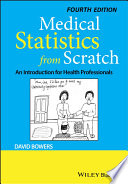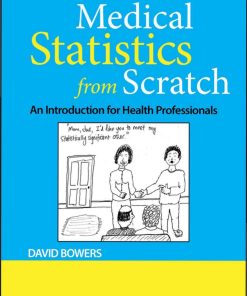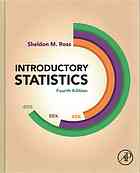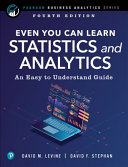Even You Can Learn Statistics and Analytics An Easy to Understand Guide 4th Edition by David Levine 9780137654789 0137654766
$50.00 Original price was: $50.00.$25.00Current price is: $25.00.
Even You Can Learn Statistics and Analytics An Easy to Understand Guide 4th Edition by David Levine – Ebook PDF Instant Download/Delivery:9780137654789, 0137654766
Full download Even You Can Learn Statistics and Analytics An Easy to Understand Guide 4th Edition after payment
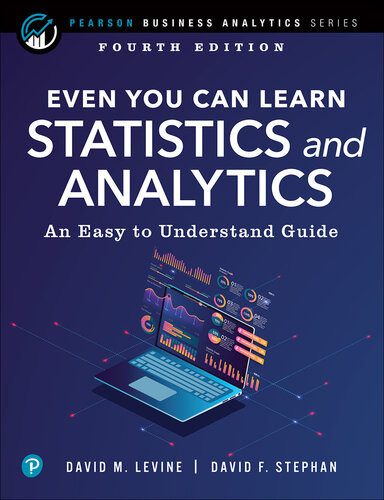
Product details:
ISBN 10: 0137654766
ISBN 13: 9780137654789
Author: David M. Levine
THE GUIDE FOR ANYONE AFRAID TO LEARN STATISTICS & ANALYTICS UPDATED WITH NEW EXAMPLES & EXERCISES This book discusses statistics and analytics using plain language and avoiding mathematical jargon. If you thought you couldn’t learn these data analysis subjects because they were too technical or too mathematical, this book is for you! This edition delivers more everyday examples and end-of-chapter exercises and contains updated instructions for using Microsoft Excel. You’ll use downloadable data sets and spreadsheet solutions, template-based solutions you can put right to work. Using this book, you will understand the important concepts of statistics and analytics, including learning the basic vocabulary of these subjects. Create tabular and visual summaries and learn to avoid common charting errors Gain experience working with common descriptive statistics measures including the mean, median, and mode; and standard deviation and variance, among others Understand the probability concepts that underlie inferential statistics Learn how to apply hypothesis tests, using Z, t, chi-square, ANOVA, and other techniques Develop skills using regression analysis, the most commonly-used Inferential statistical method Explore results produced by predictive analytics software Choose the right statistical or analytic techniques for any data analysis task Optionally, read the “Equation Blackboards,” designed for readers who want to learn about the mathematical foundations of selected methods
Even You Can Learn Statistics and Analytics An Easy to Understand Guide 4th Table of contents:
hapter 1. Fundamentals of Statistics
1.1 The First Three Words of Statistics
1.2 The Fourth and Fifth Words
1.3 The Branches of Statistics
1.4 Sources of Data
1.5 Sampling Concepts
1.6 Sample Selection Methods
Chapter 2. Presenting Data in Tables and Charts
2.1 Presenting Categorical Variables
2.2 Presenting Numerical Variables
2.3 “Bad” Charts
Chapter 3. Descriptive Statistics
3.1 Measures of Central Tendency
3.2 Measures of Position
3.3 Measures of Variation
3.4 Shape of Distributions
Chapter 4. Probability
4.1 Events
4.2 More Definitions
4.3 Some Rules of Probability
4.4 Assigning Probabilities
Chapter 5. Probability Distributions
5.1 Probability Distributions for Discrete Variables
5.2 The Binomial and Poisson Probability Distributions
5.3 Continuous Probability Distributions and the Normal Distribution
5.4 The Normal Probability Plot
Chapter 6. Sampling Distributions and Confidence Intervals
6.1 Foundational Concepts
6.2 Sampling Error and Confidence Intervals
6.3 Confidence Interval Estimate for the Mean Using the t Distribution (σ Unknown)
6.4 Confidence Interval Estimation for Categorical Variables
6.5 Confidence Interval Estimation When Normality Cannot Be Assumed
Chapter 7. Fundamentals of Hypothesis Testing
7.1 The Null and Alternative Hypotheses
7.2 Hypothesis Testing Issues
7.3 Decision-Making Risks
7.4 Performing Hypothesis Testing
7.5 Types of Hypothesis Tests
Chapter 8. Hypothesis Testing: Z and t Tests
8.1 Test for the Difference Between Two Proportions
8.2 Test for the Difference Between the Means of Two Independent Groups
8.3 The Paired t Test
Chapter 9. Hypothesis Testing: Chi-Square Tests and the One-Way Analysis of Variance (ANOVA)
9.1 Chi-Square Test for Two-Way Tables
9.2 One-Way Analysis of Variance (ANOVA): Testing for the Differences Among the Means of More Than Two Groups
Chapter 10. Simple Linear Regression
10.1 Basics of Regression Analysis
10.2 Developing a Simple Linear Regression Model
10.3 Measures of Variation
10.4 Inferences About the Slope
10.5 Common Mistakes When Using Regression Analysis
Chapter 11. Multiple Regression
11.1 The Multiple Regression Model
11.2 Coefficient of Multiple Determination
11.3 The Overall F Test
11.4 Residual Analysis for the Multiple Regression Model
11.5 Inferences Concerning the Population Regression Coefficients
Chapter 12. Introduction to Analytics
12.1 Basic Concepts
12.2 Descriptive Analytics
12.3 Typical Descriptive Analytics Visualizations
Chapter 13. Predictive Analytics
13.1 Predictive Analytics Methods
13.2 More About Predictive Models
13.3 Tree Induction
13.4 Clustering
13.5 Association Analysis
Appendix A. Microsoft Excel Operation and Configuration
A.1 Conventions for Keystroke and Mouse Operations
A.2 Microsoft Excel Technical Configuration
Appendix B. Review of Arithmetic and Algebra
Assessment Quiz
Symbols
Answers to Quiz
Appendix C. Statistical Tables
Appendix D. Spreadsheet Tips
Chart Tips
Function Tips
Appendix E. Advanced Techniques
Advanced How-To Tips
Analysis ToolPak Tips
Appendix F. Documentation for Downloadable Files
F.1 Downloadable Data Files
F.2 Downloadable Spreadsheet Solution Files
Index
People also search for Even You Can Learn Statistics and Analytics An Easy to Understand Guide 4th :
can you learn statistics on your own
can i learn statistics in a week
what can you learn from statistics
even you can learn statistics and analytics
Tags:
David Levine,Learn Statistics,Analytics
You may also like…
Business & Economics - Sales & Marketing
Pitch Like Hollywood: What You Can Learn from the High-Stakes Film Industry Peter Desberg
Technique - Electronics
Medicine - Medicine & Nursing Reference
Medical Statistics From Scratch: An Introduction for Health Professionals 4th Edition
Mathematics - Mathematical Statistics
Engineering - Engineering - General & Miscellaneous
Engineering Your Future An Australian Guide 4th Edition David Dowli
Mathematics - Mathematical Statistics
Even You Can Learn Statistics and Analytics: An Easy to Understand Guide 4th Edition








